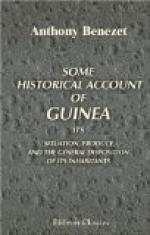J. Leo says, page 65. “That they lived in
common, having no property in land, no tyrant nor superior
lord, but supported themselves in an equal state,
upon the natural produce of the country, which afforded
plenty of roots, game, and honey. That ambition
or avarice never drove them into foreign countries
to subdue or cheat their neighbours. Thus they
lived without toil or superfluities.” “The
antient inhabitants of Morocco, who wore coats of mail,
and used swords and spears headed with iron, coming
amongst these harmless and naked people, soon brought
them under subjection, and divided that part of Guinea
which lies on the rivers Senegal and Gambia into fifteen
parts; those were the fifteen kingdoms of the Negroes,
over which the Moors presided, and the common people
were Negroes. These Moors taught the Negroes
the Mahometan religion, and arts of life; particularly
the use of iron, before unknown to them. About
the 14th century, a native Negro, called Heli Ischia,
expelled the Moorish conquerors; but tho’ the
Negroes threw off the yoke of a foreign nation, they
only changed a Libyan for a Negroe master. Heli
Ischia himself becoming King, led the Negroes on to
foreign wars, and established himself in power over
a very large extent of country.” Since
Leo’s time, the Europeans have had very little
knowledge of those parts of Africa, nor do they know
what became of his great empire. It is highly
probable that it broke into pieces, and that the natives
again resumed many of their antient customs; for in
the account published by William Moor, in his travels
on the river Gambia, we find a mixture of the Moorish
and Mahometan customs, joined with the original simplicity
of the Negroes. It appears by accounts of antient
voyages, collected by Hackluit, Purchas, and others,
that it was about fifty years before the discovery
of America, that the Portugueze attempted to sail
round Cape Bojador, which lies between their country
and Guinea; this, after divers repulses occasioned
by the violent currents, they effected; when landing
on the western coasts of Africa, they soon began to
make incursions into the country, and to seize and
carry off the native inhabitants. As early as
the year 1434, Alonzo Gonzales, the first who is recorded
to have met with the natives, being on that coast,
pursued and attacked a number of them, when some were
wounded, as was also one of the Portugueze; which the
author records as the first blood spilt by christians
in those parts. Six years after, the same Gonzales
again attacked the natives, and took twelve prisoners,
with whom he returned to his vessels; he afterwards
put a woman on shore, in order to induce the natives
to redeem the prisoners; but the next day 150 of the
inhabitants appeared on horses and camels, provoking
the Portugueze to land; which they not daring to venture,
the natives discharged a volley of stones at them,
and went off. After this, the Portugueze still
continued to send vessels on the coast of Africa;




